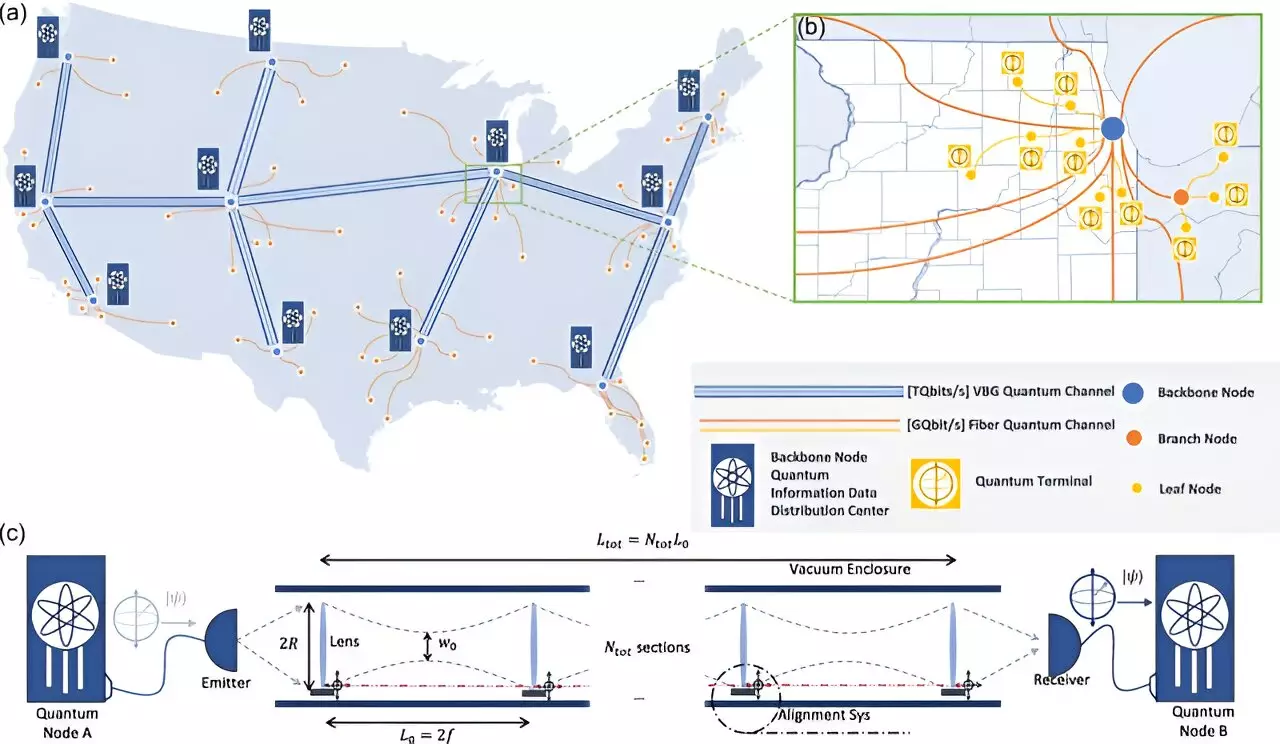Quantum computing stands on the precipice of transforming various sectors, most notably in the realms of cybersecurity, communications, and data processing. More than just a technological advancement, the full potential of quantum computing is realized only when these powerful machines are interconnected through robust quantum networks or a ‘quantum internet.’ The implications of such a network are vast, ranging from secure communications to the creation of distributed quantum computing systems and novel observational technologies. However, establishing a practical platform for these quantum networks has posed significant challenges, which researchers are now actively addressing.
Recent developments from an innovative team at the University of Chicago Pritzker School of Molecular Engineering have put forth a compelling solution: utilizing vacuum-sealed tubes in combination with lenses to create long-range quantum channels. These concepts, which underscore the cutting-edge of quantum technology, point toward a future where quantum setups can efficiently transmit information over thousands of kilometers. Given the anticipated capacity of over 10 trillion qubits per second, the implications for increasing communication speed and security are nothing short of revolutionary.
The Science Behind Quantum Computation
To appreciate the ingenuity of this approach, one must delve into the unique characteristics that define quantum computing. Unlike classical computers which operate with binary bits (0 or 1), quantum computers harness qubits that can exist in multiple states at once through phenomena like superposition and entanglement. This enables quantum systems to perform complex calculations and analyses that classical systems cannot match. Qubits exhibit interconnectedness that transcends vast spatial distances, a property known as entanglement, which can provide unparalleled security and data integrity for transmitted information.
However, traditional networks that are utilized for connecting computers have significant limitations when it comes to preserving the qubit’s delicate properties during transmission. As expressed by Liang Jiang, a pioneer in this field, classic data transmission falls short: “You can’t send a quantum state over a classical network.” This challenge has spurred researchers to explore alternatives that could maintain quantum fidelity in data communication.
Fusion of Techniques for Brilliance
Innovations thus far have included attempts to use fiber optic cables and satellites to send optical photons, which can double as qubits. While fiber optics allow some degree of data transmission, photons tend to suffer from absorption losses over distances, limiting their effectiveness. Conversely, satellites benefit from the lack of atmospheric interference in space, yet they remain constrained by environmental factors that inhibit the quantum state retention of the photons being transmitted.
The researchers at the University of Chicago aim to synthesize the advantages of both methods, proposing a groundbreaking idea: long-distance, ground-based vacuum tubes. Drawing inspiration from existing technologies like the Laser Interferometer Gravitational-Wave Observatory (LIGO), which has successfully managed to transmit photons using large-scale vacuum environments, the team believes that smaller vacuum tubes could allow for effective photon transportation across cities or even states. The goal is to engineer these vacuum systems to maintain medium vacuum levels, a more practical requirement compared to the ultra-high vacuums used in gravitational wave research.
Lens Technology: A Game Changer
One of the most significant hurdles in realizing this vision pertains to the diffraction of light during transmission. As photons propagate through a vacuum, they naturally spread out, diminishing their focus and resolution over long distances. To counteract this challenge, Jiang and his team propose the strategic placement of lenses every few kilometers. By focusing and guiding the beam, these lenses would prevent information loss, maintaining the integrity of the quantum states transmitted along the network.
While these theoretical designs currently stand on paper, the researchers are poised to embark on practical experiments to validate their hypotheses. Collaborating with experts from institutions like Caltech, the team aims to test the optimization of lens placement and photon stabilizing techniques using existing LIGO vacuum tubes.
Future Vision and Challenges
As intriguing as these advancements are, significant engineering obstacles remain before these quantum networks can accentuate our technological landscape. The construction and maintenance of extensive vacuum systems will not only require scientific ingenuity but also an integrated approach from civil engineering perspectives. The pathway to a quantum internet is laden with complex challenges, but the potential rewards are transformative.
The quest for a quantum future, harnessing the principles of quantum connectivity, elucidates a vision where secure communications become commonplace, new computational paradigms are developed, and previously unthought-of technologies emerge. As researchers continue to push the boundaries of what is possible, one cannot help but feel excitement for the future: a landscape where quantum technology liberates us from the constraints of classical computing, redefining connections across the globe.

